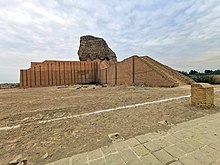
Back زقورة عقرقوف Arabic Дур-Куригальзу Bashkir Dur-Kurigalzu Catalan دور کوریگالزو CKB Dur-Kurigalzu Czech Aqarquf German Dur-Kurigalzu Spanish Dur-Kurigalzu Basque دور کوریگالزو Persian Dûr-Kurigalzu French
عَقَرْقُوف Dur-Kurigalzu | |
 The ziggurat of Dur-Kurigalzu, December 2021 | |
| Location | Baghdad Governorate, Iraq |
|---|---|
| Region | Mesopotamia |
| Coordinates | 33°21′13″N 44°12′8″E / 33.35361°N 44.20222°E |
| Type | tell |
| Length | – |
| Area | 225 ha (560 acres) |
| Site notes | |
| Excavation dates | 1942–1945 |
| Archaeologists | Taha Baqir, S. Lloyd |
Dur-Kurigalzu (modern `Aqar-Qūf عَقَرْقُوف in Baghdad Governorate, Iraq) was a city in southern Mesopotamia, near the confluence of the Tigris and Diyala rivers, about 30 kilometres (19 mi) west of the center of Baghdad. It was founded by a Kassite king of Babylon, Kurigalzu I (died c. 1375 BC) and was abandoned after the fall of the Kassite dynasty (c. 1155 BC). The city was of such importance that it appeared on toponym lists in the funerary temple of the Egyptian pharaoh, Amenophis III (c. 1351 BC) at Kom el-Hettan".[1] The prefix Dur is an Akkadian term meaning "fortress of", while the Kassite royal name Kurigalzu is believed to have meant "shepherd of the Kassites".[2][3] The tradition of naming new towns Dur dates back to the Old Babylonian period with an example being Dūr-Ammī-ditāna. The city contained a ziggurat and temples dedicated to Mesopotamian gods, as well as a royal palace which covered 420,000 square meters.[4]
The ziggurat at Aqar Quf, standing to a height of about 52 metres (171 ft), has been a very visible ancient monument for centuries. For camel caravans and modern road traffic, the ziggurat has served as a signal of the near approach to Baghdad. Because of Aqar Quf's easy accessibility and close proximity to the city of Baghdad, it has been one of Iraq's most visited and best-known sites. The ziggurat was often confused with the Tower of Babel by Western visitors to the area from the 17th century onwards.[5]
- ^ Edel, E./M. Görg (2005): Die Ortsnamenlisten im nördlichen Säulenhof des Totentempels Amenophis' III. Ägypten und Altes Testament 50. Wiesbaden
- ^ J.A. Brinkman, (1976) A catalogue of cuneiform sources pertaining to specific monarchs of the Kassite Dynasty. Materials and Studies for Kassite History 1. Chicago
- ^ Balkan, K. (1954): Kassitenstudien 1. Die Sprache der Kassiten. AOS 37.
- ^ Cite error: The named reference
clayden96was invoked but never defined (see the help page). - ^ Cite error: The named reference
clayden17was invoked but never defined (see the help page).
© MMXXIII Rich X Search. We shall prevail. All rights reserved. Rich X Search
